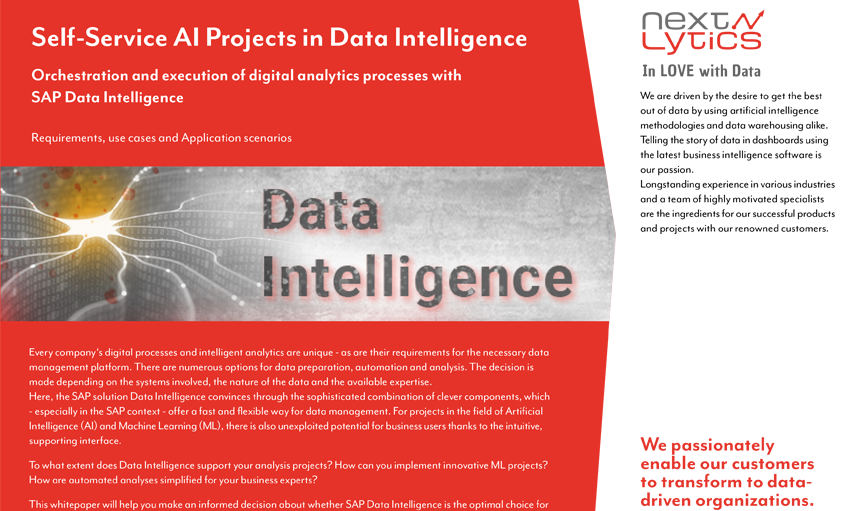The intuitive future of data management and analytics
Working with data inevitably means organizing it. Especially in advanced analyses with artificial intelligence (AI), the combining, preparation and cleaning of the data determine a large part of a analytical project. In order to achieve the defined analysis goal, different data formats such as streaming data, relational data and Excel files have to be joined. The merging and data preparation is ad-hoc and must withstand ever-increasing data volumes.
While data integration and preparation is also possible in traditional systems, these are mostly specialized for expert users. Modern data management platforms for AI projects, however, are a place for collaboration and bring diverse users close to data. Visual representations of processes, a flow supportive user experience, and a low-code mentality keep barriers to entry low and clear the way for self-service analytics.

The data management solution SAP Data Intelligence combines usability for beginners, functionality for experts and scalability of data processing in one system. The successor to SAP Data Hub with the integration of SAP Leonardo Machine Learning has been available to end customers since 2019 and is being continuously developed.
Self-service analyses in an intuitive web interface
‣ Data Integration
Unite different types of data with ETL or alternative ELT processes. Operational connections to SAP systems as well as non-SAP systems are available. Data from an Excel spreadsheet can be used in the same way as from an IoT stream.
‣ Organized overview of your analysis data
The data is centrally bundled in the data management solution. An integrated data lake is available for heterogeneous file formats. Comprehensive metadata management and transferable rules to ensure data quality help with the necessary organization.
‣ Data Orchestration
In the Modeler component, you can create any desired complex workflow for your data processes using drag-and-drop. The visual representation ensures transparency and a recognition value of the operatores and steps.
‣ Ready for Artificial Intelligence
The data science process is optimally supported by an interaction of various components. With the ML Scenario Manager, the exploratory data analysis, the workflow and the models including the associated target metrics are provided in a versioned manner.
‣ Free creation with R and Python
A built-in JupyterLab instance allows scripts in the programming languages R and Python to be integrated. SAP is thus opening up to the rapid change in open source technologies and providing advanced users with up-to-date algorithms.
‣ Reusability
SAP Data Intelligence emphasizes reusability. Automatic rules to ensure data quality and workflow parts, as well as user-defined operators, are easily transferable. Development time benefits from the very beginning due to numerous templates for diverse application scenarios.
‣Automatic Scaling
With a strong backend of well-proven SAP technology in combination with open source systems such as Kubernetes and Docker, the technical realization of data processing is no longer a concern. Work is performed on a data extract and the overall processing is started at the push of a button.
A glimpse inside the UI of Data Intelligence
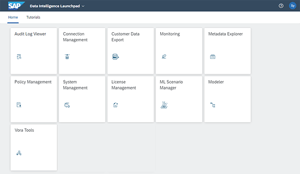
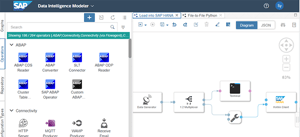
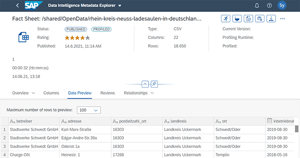

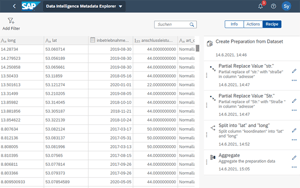
Interfaces to other systems
- SAP HANA
- SAP S/4HANA
- SAP S/4HANA Cloud
- SAP BW
- SAP BW/4HANA
- SAP Analytics Cloud
- Cloud Data Integration (z. B. SAP SuccessFactors)
- Workflows (z. B. BW Process Chains)
- Streaming (z. B. IoT, Kafka)
- Cloud Storages (z. B. Amazon S3)
- Hadoop / HDFS
- Rest APIs
- Databases (z. B. MSQL, Oracle)
- Public Clouds
- 3rd Party Applications
- SAP Cloud Platform Connectors
The data management for AI projects
Easy to get started
Thanks to the easily accessible web interface, low-code functionalities for the most important data preparation steps and the visual representation of the workflow design, business users quickly find their way around and implement their own analyses.
![]()
All-in-one Data Science
All phases of a data science project can be bundled in SAP Data Intelligence. Data, models and deployment all find their place here and are presented visually.
![]()
Individual pricing
SAP Data Intelligence Cloud is available as a subscription or pay-as-you-go model and is delivered on-premise in your own data center, private cloud or via all major cloud service providers.
![]()
![]()
Platform for collaborative AI applications
Due to the central access to different data sources, data ratings and commenting functions, Data Intelligence can be used as a creative space for individual data projects with AI content. Due to the low entry threshold, business users can be inspired to implement their own ideas. The Data Science Journey is flexibly guided by the structure of the ML Scenario Manager.
![]()
End-to-End Machine Learning
Your Machine Learning projects will benefit most from Data Intelligence. The bundling of project information in the ML Scenario Manager, the realization of complex workflows in the Modeler and the execution including extracted target metrics are only a few advantages worth mentioning. The versioning and transparency also convinces expert users.
Would you like to know more about SAP Data Intelligence?
Find interesting articles about this topic in our Blog
Data Platform Architecture with SAP Datasphere & Databricks
As digitalization advances, the amount of data that companies have to process is growing, along...

SAP DI (Data Intelligence) and the Future of Business Data Platforms
For the last couple of years, SAP Data Intelligence has been the company’s consolidated solution...

SAP Data Intelligence - SAP enables self-service AI-projects
Self-service solutions are also becoming increasingly popular in the field of artificial...

























